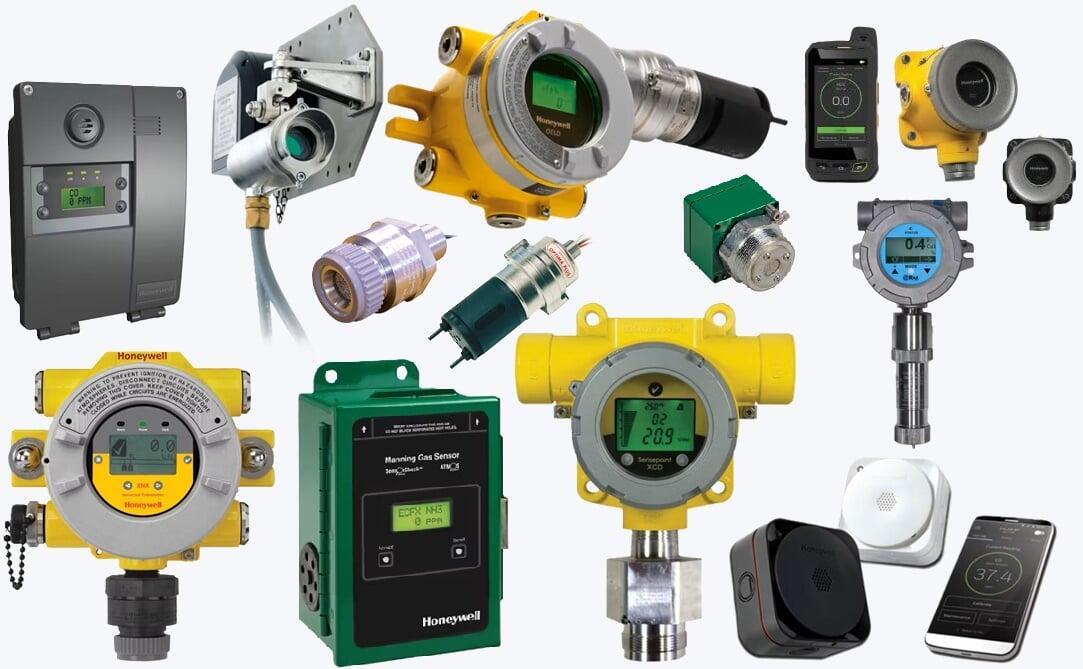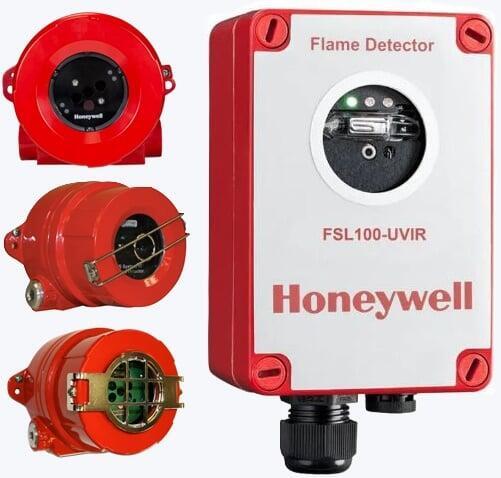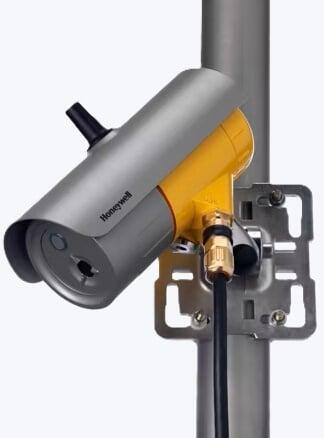
Gas, Flame, & Leak Detectors
At Clipper Controls, we offer a comprehensive range of gas, flame, and leak detectors designed to enhance safety and reliability across industrial operations. These critical detection systems provide early warning and protection against hazardous conditions by continuously monitoring for combustible gases, toxic gases, vapors, flames, and leaks that can pose serious risks to people, equipment, and the environment. Serving industries such as oil and gas, chemical processing, manufacturing, and utilities, Clipper Controls delivers advanced sensing solutions built for precision, durability, and rapid response. Our expert team is here to help you select and integrate the right detection technology to ensure safety, compliance, and operational excellence.
Gas Detectors
Application: Gas detectors are used to continuously monitor ambient or confined spaces for the presence of hazardous gases, including combustible gases (LEL monitoring), toxic gases (such as H₂S, CO, or NH₃), and oxygen depletion or enrichment. These detectors are commonly deployed in industrial plants, confined entry points, laboratories, and hazardous process areas to trigger alarms, initiate ventilation systems, or shut down equipment in the event of a dangerous gas concentration. Available in fixed, portable, and wireless configurations, gas detectors are essential for compliance with safety standards, worker protection, and environmental monitoring.

Flame Detectors
Application: Flame detectors are optical sensing devices engineered to identify the presence of an open flame or fire at its earliest stages by detecting ultraviolet (UV), infrared (IR), or combined UV/IR or multi-spectrum signatures. These detectors are widely used in high-risk environments such as refineries, chemical plants, fuel storage facilities, and power generation sites where rapid flame detection is critical for safety. Flame detectors provide fast and reliable alarm activation, enabling automated fire suppression systems or emergency shutdown procedures to minimize risk to personnel, equipment, and operations.

Sonic Leak Detectors
Application: Sonic leak detectors use ultrasonic sensing technology to detect the high-frequency sound waves generated by pressurized gas or air escaping from a system. These detectors are highly effective for identifying leaks in compressed air lines, vacuum systems, steam traps, and gas pipelines, even in noisy industrial environments. By converting ultrasonic signals into audible sounds or visual indicators, sonic leak detectors allow maintenance personnel to quickly pinpoint leak sources, improve energy efficiency, and reduce the risk of unplanned downtime or safety hazards.

Need Help?
Our Crew is Here To Serve You!
Gas, Flame, & Leak Detection Applications
Oil & Gas Applications
In the oil and gas industry, gas, flame, and leak detection systems are essential for ensuring the safety, efficiency, and environmental compliance of operations across upstream, midstream, and downstream sectors. These detection systems provide early warning of hazardous gas releases, flame presence, or leaks, enabling rapid response to prevent catastrophic events, protect personnel, and minimize operational disruptions. Implementing robust detection technology helps companies comply with strict industry regulations, reduces environmental impact, and supports continuous, reliable operation.
- Drilling Rig Safety Monitoring
Purpose: Drilling rigs are exposed to volatile gases such as methane and hydrogen sulfide. Gas detectors monitor the rig environment to detect combustible and toxic gases, triggering alarms and automatic safety systems when hazardous concentrations are present. Flame detectors provide immediate detection of any ignition source, helping prevent blowouts and fires. - Refinery Process Monitoring
Purpose: Refineries process flammable and toxic chemicals, making gas and flame detection critical for plant safety. Gas detectors monitor key processing units for leaks of hydrocarbons and toxic gases, while flame detectors safeguard areas prone to fire hazards. Leak detectors also identify small process leaks before they escalate, ensuring both safety and regulatory compliance. - Pipeline Transport Monitoring
Purpose: Pipelines transport gases and liquids across vast distances, where undetected leaks can cause environmental damage and safety risks. Gas detectors monitor for leaks along the pipeline route, while ultrasonic leak detectors identify pressurized gas escaping from joints and fittings. Integrated monitoring systems provide real-time alerts to control centers for immediate action. - Compressor Station Monitoring
Purpose: Compressor stations boost gas pressure in transmission pipelines and are at high risk for leaks and fires. Gas detectors continuously monitor for combustible gas accumulation, and flame detectors safeguard equipment from potential ignition. Leak detection systems help quickly locate leaks to prevent escalation and maintain system integrity. - Storage Tank and Terminal Monitoring
Purpose: Storage tanks and terminals handle large volumes of hydrocarbons, posing significant fire and explosion risks. Fixed gas detectors monitor tank surroundings for vapor releases, while flame detectors provide rapid flame detection. Leak detectors are deployed to monitor tank bottoms, piping, and valves, ensuring containment and preventing hazardous releases. - Offshore Platform Monitoring
Purpose: Offshore oil and gas platforms operate in high-risk environments where early detection of gas leaks and flames is vital. Gas detectors monitor confined spaces and process areas for hazardous gases, flame detectors provide optical detection of fires, and leak detectors help locate gas or oil leaks in marine conditions to prevent environmental contamination and protect personnel. - Machinery Spaces and Enclosed Areas Monitoring
Purpose: Enclosed machinery spaces, including engine rooms and generator compartments, require continuous monitoring for gas leaks that could lead to fire or explosion. Gas detectors ensure safe operating conditions, and flame detectors provide rapid detection of any ignition source. Leak detectors enhance safety by identifying pressurized gas leaks in confined areas. - Flaring and Venting Area Monitoring
Purpose: Flaring systems are used to burn off excess hydrocarbons safely, but malfunctions can lead to uncontrolled releases or incomplete combustion. Gas and flame detectors monitor flaring and venting zones to ensure that gas is being properly combusted and to detect any unintended releases or fires in surrounding areas.
Power Generation Applications
In the power generation industry, gas, flame, and leak detection systems are critical for safeguarding personnel, protecting valuable assets, and ensuring uninterrupted operations. Power plants handle flammable gases, combustible materials, and pressurized systems that pose significant fire, explosion, and environmental risks. Integrated detection systems provide early warnings of hazardous conditions, allowing operators to respond quickly to prevent accidents, maintain regulatory compliance, and optimize plant reliability.
- Gas Turbine Monitoring
Purpose: Gas turbines use fuel gases that present fire and explosion hazards. Gas detectors monitor turbine enclosures for combustible gas leaks, while flame detectors provide rapid identification of ignition events. These systems help protect turbine units from catastrophic failures and ensure safe operation. - Boiler and Combustion Chamber Monitoring
Purpose: Boilers and combustion chambers are high-risk areas where fuel gases are ignited to generate steam. Gas detectors monitor for leaks of natural gas or fuel oil, and flame detectors confirm the presence of pilot flames or burners. Leak detection ensures that fuel delivery systems remain sealed and safe. - Fuel Handling and Storage Monitoring
Purpose: Fuel storage tanks and delivery systems contain flammable liquids and gases that must be continuously monitored. Gas and flame detectors safeguard loading areas, storage tanks, and transfer stations by detecting vapor leaks and flames, reducing the risk of fire and environmental incidents. - Generator Room Monitoring
Purpose: Generator rooms can accumulate combustible gases due to leaks from fuel supply lines or lubrication systems. Gas detectors monitor ambient air quality, and flame detectors provide immediate response to any ignition source, helping prevent fires and explosions within enclosed spaces. - Hydrogen Cooling System Monitoring
Purpose: Large generators often use hydrogen for cooling, which is highly flammable. Gas detectors are deployed to monitor for hydrogen leaks in generator casings, auxiliary systems, and storage facilities. Early leak detection is essential to prevent dangerous gas accumulations and potential explosions. - Turbine Hall and Auxiliary Equipment Monitoring
Purpose: Turbine halls and auxiliary equipment areas require monitoring for combustible gas leaks and flame events. Gas detectors are positioned near pumps, valves, and pipework, while flame detectors provide additional protection in case of ignition, ensuring overall plant safety. - Flue Gas and Exhaust System Monitoring
Purpose: Exhaust stacks and flue gas systems must be monitored for leaks and incomplete combustion. Gas detectors track emissions for compliance and safety, while flame detectors verify combustion performance and detect potential flare malfunctions or stack fires. - Battery Storage and Emergency Power Monitoring
Purpose: Battery rooms and emergency power supply systems may generate hydrogen gas during charging cycles. Gas detectors monitor for hydrogen buildup to prevent explosive atmospheres, especially in enclosed or poorly ventilated areas.
Chemical Manufacturing Applications
In the chemical manufacturing industry, gas, flame, and leak detection systems are vital for maintaining plant safety, protecting personnel, and ensuring environmental compliance. Facilities often handle flammable, toxic, and reactive chemicals that pose significant fire, explosion, and exposure risks. Integrated detection systems help identify hazardous releases early, allowing operators to mitigate risks quickly, maintain process integrity, and adhere to strict safety and regulatory standards.
- Reactor and Processing Vessel Monitoring
Purpose: Chemical reactors and processing vessels operate with volatile and hazardous substances. Gas detectors monitor for leaks of flammable or toxic gases, while flame detectors safeguard areas prone to ignition. Leak detection systems help prevent the release of dangerous chemicals, ensuring process safety and compliance. - Storage Tank and Bulk Transfer Monitoring
Purpose: Storage tanks and transfer systems handle large volumes of chemicals that can present serious hazards if released. Gas detectors monitor for vapor leaks around tanks and transfer stations, while flame detectors provide rapid response to any ignition. Leak detection systems ensure the containment of materials and reduce environmental risks. - Piping and Valve Network Monitoring
Purpose: Extensive piping systems transport raw materials and finished products throughout chemical plants. Gas detectors are positioned along pipelines and near valves to detect leaks, and leak detection systems identify early-stage failures to minimize product loss and safety risks. - Mixing and Blending Station Monitoring
Purpose: Mixing and blending operations often involve flammable or reactive substances. Gas and flame detectors are used to monitor for hazardous vapors and ignition sources, providing essential protection against fires and explosions during processing. - Packaging and Filling Line Monitoring
Purpose: Filling and packaging lines can be vulnerable to leaks, particularly when dealing with pressurized or volatile products. Gas detectors monitor these lines for accidental releases, and leak detection systems ensure that any issues are quickly identified to maintain safety and prevent product loss. - Scrubber and Vent System Monitoring
Purpose: Scrubber and vent systems handle off-gases and emissions from various processes. Gas detectors monitor for leaks or emissions of hazardous gases, and flame detectors provide additional protection in areas where flammable gases may accumulate, ensuring environmental compliance and worker safety. - Laboratory and R&D Area Monitoring
Purpose: On-site laboratories and R&D areas work with a wide variety of chemicals, often in small but hazardous quantities. Gas detectors ensure that the air remains free of dangerous vapors, while flame detectors provide critical protection in case of accidental ignition during experiments. - Waste Treatment and Effluent Monitoring
Purpose: Chemical plants generate waste streams that may contain flammable or toxic gases. Gas detectors monitor treatment areas for leaks or releases, and flame detectors ensure safe handling of combustible effluents, helping facilities meet environmental and safety requirements.
Aerospace & Defense Applications
In the aerospace and defense industry, gas, flame, and leak detection systems are crucial for ensuring the safety, integrity, and performance of mission-critical operations. Facilities handle high-energy fuels, pressurized gases, and sensitive materials that present unique safety challenges. Detection systems help mitigate risks associated with leaks, fires, and explosions, supporting both ground operations and testing environments while maintaining compliance with stringent safety and environmental standards.
- Fuel Storage and Handling Monitoring
Purpose: Aerospace facilities store and handle large quantities of jet fuel, rocket propellants, and other high-energy fuels. Gas detectors monitor for vapor leaks, while flame detectors provide rapid response in case of ignition. Leak detection ensures containment and helps prevent catastrophic fuel-related incidents. - Engine Test Cell Monitoring
Purpose: Engine test cells operate under extreme conditions with high heat and fuel use. Gas detectors monitor for combustible gas leaks during testing, and flame detectors quickly identify fire events. These systems protect personnel, equipment, and facilities during critical engine evaluations. - Propellant Manufacturing and Storage Monitoring
Purpose: Manufacturing and storage of solid and liquid propellants require constant monitoring for gas leaks and potential ignition sources. Gas and flame detectors safeguard these sensitive areas, ensuring process integrity and preventing hazardous incidents. - Missile and Weapons System Monitoring
Purpose: Missile assembly and maintenance areas involve handling of fuels and pressurized systems. Gas detectors are used to monitor for leaks of hazardous materials, while flame detectors provide additional protection against accidental ignition during critical assembly or maintenance tasks. - Composite Fabrication and Coating Monitoring
Purpose: Composite materials and coatings often involve the use of volatile solvents and chemicals. Gas detectors monitor air quality to detect hazardous vapors, while flame detectors safeguard areas where flammable vapors may accumulate, ensuring a safe work environment. - Ground Support Equipment Monitoring
Purpose: Ground support equipment, including generators, fueling systems, and maintenance vehicles, require monitoring for gas leaks and flame risks. Gas and flame detectors help prevent equipment-related incidents, ensuring operational safety on flight lines and in hangars. - Spacecraft Assembly and Cleanroom Monitoring
Purpose: Spacecraft assembly facilities and cleanrooms handle pressurized systems and sensitive components. Gas detectors monitor for leaks of oxygen, nitrogen, or other gases used in testing and assembly, while flame detectors provide rapid response to any ignition events, ensuring mission success and personnel safety. - Hangar and Facility Monitoring
Purpose: Aircraft hangars and defense facilities house high-value assets and use flammable materials during maintenance. Gas and flame detectors provide continuous monitoring to detect hazardous gas buildup or fire risks, protecting infrastructure and personnel from potential incidents.
Pharmaceutical & Laboratory Applications
In pharmaceutical manufacturing and laboratory environments, gas, flame, and leak detection systems are critical for ensuring worker safety, protecting sensitive processes, and maintaining compliance with stringent health, safety, and environmental standards. These facilities often work with flammable solvents, pressurized gases, and hazardous chemicals, making continuous monitoring essential to prevent accidents, contamination, and costly disruptions.
- Solvent Storage and Handling Monitoring
Purpose: Pharmaceutical processes frequently use flammable solvents like ethanol, acetone, and isopropanol. Gas detectors monitor for solvent vapor leaks in storage and handling areas, while flame detectors provide early detection of ignition events, helping to prevent fires and ensure facility safety. - Cleanroom and Controlled Environment Monitoring
Purpose: Cleanrooms and controlled environments require precise air quality control. Gas detectors monitor for hazardous gas leaks that could compromise product integrity or pose health risks, while flame detectors add a layer of protection in critical areas where flammable materials are used. - Reactor and Processing Vessel Monitoring
Purpose: Pharmaceutical reactors and vessels often involve chemical reactions with flammable or toxic gases. Gas and flame detectors ensure safe processing by monitoring for leaks and providing rapid flame detection to prevent fire or explosion incidents. - Gas Cylinder Storage and Utility Monitoring
Purpose: Pressurized gas cylinders containing nitrogen, oxygen, or specialty gases are used throughout pharmaceutical facilities and labs. Gas detectors monitor cylinder storage areas for leaks, ensuring a safe environment for personnel and compliance with safety standards. - Analytical Laboratory Monitoring
Purpose: Laboratories use various flammable and toxic gases for testing and analysis. Gas detectors are essential for monitoring lab spaces to maintain safe air quality, while flame detectors provide protection in case of accidental ignition during experiments. - HVAC and Exhaust System Monitoring
Purpose: HVAC systems and exhaust ducts must be monitored to ensure the safe removal of hazardous gases. Gas detectors check for leaks or blockages, while flame detectors safeguard against fires within ventilation systems, ensuring continuous protection. - Waste Handling and Effluent Monitoring
Purpose: Pharmaceutical waste streams may contain flammable or toxic residues. Gas detectors monitor waste handling areas and effluent treatment systems for leaks or releases, and flame detectors provide additional protection against fire risks. - Production Line and Packaging Area Monitoring
Purpose: Production lines and packaging areas, especially those handling volatile substances, benefit from gas and flame detection systems that monitor for leaks and fire hazards, ensuring uninterrupted, safe operation and compliance with Good Manufacturing Practices (GMP).
Food & Beverage Processing Applications
In the food and beverage processing industry, gas, flame, and leak detection systems are essential for ensuring worker safety, protecting product integrity, and maintaining compliance with health, safety, and environmental regulations. Facilities often use flammable refrigerants, carbon dioxide, and pressurized gases, making continuous monitoring critical to prevent accidents, maintain production uptime, and safeguard consumers.
- Ammonia Refrigeration System Monitoring
Purpose: Ammonia is commonly used as a refrigerant in large-scale cooling systems. Gas detectors monitor for ammonia leaks in refrigeration machinery rooms and cold storage areas, while flame detectors provide added protection in case of ignition, ensuring compliance with safety codes and protecting workers. - Carbon Dioxide System Monitoring
Purpose: Carbon dioxide is used for carbonation and as a refrigerant. Gas detectors monitor CO2 levels in bottling plants, breweries, and cold storage areas to prevent hazardous accumulations that can pose health risks in confined spaces. - Cooking and Frying Area Monitoring
Purpose: Cooking and frying areas can experience grease fires and gas leaks. Gas detectors monitor for leaks from cooking gas lines, and flame detectors provide early warning of open flames or flare-ups, helping prevent fire hazards in production kitchens. - Packaging and Modified Atmosphere Monitoring
Purpose: Modified atmosphere packaging (MAP) uses gases like nitrogen and carbon dioxide to preserve freshness. Gas detectors monitor packaging areas for leaks, ensuring worker safety and product quality during packaging processes. - Fermentation and Brewery Monitoring
Purpose: Breweries and fermentation tanks generate carbon dioxide as a byproduct. Gas detectors monitor for CO2 buildup to maintain safe air quality in production spaces, especially in confined or low-ventilation areas. - Cold Storage and Warehouse Monitoring
Purpose: Cold storage warehouses that use refrigerants like ammonia or CO2 are monitored with gas detectors to detect leaks, ensuring safe conditions for workers and product preservation. Flame detectors add another layer of protection in case of accidental ignition. - Boiler and Utility Room Monitoring
Purpose: Boilers and utility areas use fuel gases that must be carefully monitored. Gas detectors check for leaks in fuel supply lines, while flame detectors ensure that burners and pilot flames are operating safely, preventing fire and explosion risks. - Waste Treatment and Effluent Monitoring
Purpose: Food processing generates wastewater and organic waste that can produce combustible gases. Gas detectors monitor waste treatment facilities for hazardous gas emissions, while flame detectors safeguard against accidental ignition, ensuring environmental compliance and safety.
Utility & Water Treatment Applications
In the utilities and water treatment sectors, gas, flame, and leak detection systems are essential for ensuring safe operations, protecting infrastructure, and maintaining compliance with environmental and safety regulations. Facilities handle a variety of hazardous gases, including methane, chlorine, and hydrogen sulfide, which pose risks of explosion, fire, and exposure. Continuous monitoring helps prevent incidents, supports efficient maintenance, and ensures uninterrupted service delivery to communities.
- Chlorine Storage and Dosing System Monitoring
Purpose: Chlorine is widely used for disinfection in water treatment. Gas detectors monitor for chlorine leaks in storage and dosing areas, providing early warning of hazardous exposures and helping maintain safe working conditions and regulatory compliance. - Biogas and Methane Monitoring
Purpose: Wastewater treatment facilities often produce biogas, which contains methane, a flammable gas. Gas detectors monitor for methane leaks in digesters and gas handling systems, while flame detectors provide rapid fire detection to safeguard equipment and personnel. - Oxygen Deficiency Monitoring
Purpose: Confined spaces, such as tanks and vaults, pose risks of oxygen deficiency due to displacement by other gases. Oxygen sensors and gas detectors monitor air quality in these areas to protect workers during entry and maintenance operations. - Hydrogen Sulfide Monitoring
Purpose: Hydrogen sulfide is a toxic gas commonly found in wastewater treatment processes. Gas detectors continuously monitor for H2S leaks in sewer systems, digesters, and pump stations, providing early warnings to protect worker safety. - Generator and Boiler Room Monitoring
Purpose: Utility plants use boilers and backup generators fueled by natural gas or diesel. Gas detectors monitor these spaces for leaks in fuel supply lines, and flame detectors ensure burners and combustion systems operate safely, reducing fire risks. - Gas Chlorination Facility Monitoring
Purpose: Gas chlorination facilities require continuous monitoring to detect any leaks of chlorine gas. Gas detectors provide real-time monitoring to prevent exposure, while flame detectors safeguard against potential ignition of flammable byproducts. - Pump Station and Lift Station Monitoring
Purpose: Pump and lift stations may accumulate flammable or toxic gases. Gas detectors monitor for hazardous gas buildup, and flame detectors add protection in areas where ignition sources are present, ensuring reliable and safe operation. - Landfill Gas Recovery Monitoring
Purpose: Landfill sites that recover methane for energy require robust monitoring systems. Gas detectors track methane levels to prevent leaks, while flame detectors provide safety oversight around flaring and energy recovery equipment.
Terms & Definitions
- Calibration
- The process of testing and adjusting gas and flame detectors to ensure their accuracy in measuring gas concentrations or detecting flames.
- Combustible Gas
- A gas that can catch fire and burn when mixed with air and exposed to an ignition source. Examples include methane, propane, and hydrogen.
- Electrochemical Sensor
- A type of gas sensor that detects gases through a chemical reaction that generates an electrical signal proportional to gas concentration.
- False Alarm
- An alarm triggered by a detector in the absence of an actual hazardous event, often caused by environmental factors like dust, steam, or lighting interference.
- Fire Triangle
- A model describing the three elements required for combustion: fuel, oxygen, and an ignition source. Gas, flame, and leak detection systems help monitor and control these elements to prevent fires.
- Flame Detector
- A safety device that uses optical sensing technology—such as ultraviolet (UV), infrared (IR), or multi-spectrum—to detect open flames or combustion events quickly.
- Gas Detector
- An instrument that monitors air for the presence of specific gases and alerts personnel when hazardous concentrations are detected.
- Hazardous Area Classification
- A system for defining areas where explosive gas atmospheres may occur, guiding the selection of appropriate equipment. Common classifications include Class I, Division 1 & 2 (North America) and Zone 0, 1 & 2 (IEC/ATEX).
- Infrared (IR) Detection
- A sensing technique that identifies gases or flames by detecting specific infrared radiation patterns associated with them.
- Intrinsically Safe
- A design approach ensuring that electrical equipment is incapable of releasing enough energy to ignite a flammable gas or vapor, even under fault conditions.
- Leak Detector
- A device that identifies and locates leaks of gases or liquids in pipelines, tanks, or pressurized systems, enabling timely maintenance and hazard prevention.
- Lower Explosive Limit (LEL)
- The lowest concentration of a combustible gas in air that can ignite and sustain combustion. Monitoring LEL levels helps prevent explosive atmospheres.
- Open-Path Gas Detector
- A detector that monitors gas concentrations over a distance between a transmitter and a receiver, ideal for covering large areas or perimeters.
- Oxygen Deficiency
- A condition where oxygen levels fall below safe breathing levels (typically below 19.5% in air), posing suffocation hazards.
- Point Gas Detector
- A detector that monitors gas concentration at a single, fixed location, typically used for localized hazard detection.
- Safety Instrumented System (SIS)
- An engineered safety system designed to monitor conditions and automatically initiate protective actions—such as shutting down equipment or activating alarms—when unsafe conditions are detected.
- Toxic Gas
- A gas that is harmful or fatal to humans upon inhalation or exposure, even in small concentrations. Common toxic gases include hydrogen sulfide (H2S), carbon monoxide (CO), and chlorine (Cl2).
- Ultrasonic Leak Detection
- A method of detecting leaks based on the ultrasonic sound waves generated by pressurized gas escaping from a system.
- Upper Explosive Limit (UEL)
- The highest concentration of a combustible gas in air at which combustion can occur. Concentrations above this are too rich to burn.
Frequently Asked Questions
How do flame detectors work?
Flame detectors use optical sensors to identify the specific wavelengths of ultraviolet (UV), infrared (IR), or multi-spectrum light emitted by open flames. By continuously scanning for flame signatures, these detectors can quickly recognize fire events—even in environments with smoke, dust, or varying light conditions—and trigger alarms or fire suppression systems.
Where should gas and flame detectors be installed?
What types of gases can be monitored by industrial gas detectors?
How often should gas and flame detectors be tested or calibrated?
Regular testing and calibration are essential to ensure reliable performance. Best practices recommend testing gas detectors monthly and calibrating them at least every 6 to 12 months, depending on the manufacturer's guidelines, environmental conditions, and regulatory requirements. Flame detectors should also undergo regular functional testing and maintenance.
Can detection systems be integrated with existing safety and control systems?
Yes, modern gas, flame, and leak detection systems are designed to integrate seamlessly with distributed control systems (DCS), safety instrumented systems (SIS), building management systems (BMS), and fire suppression systems. This allows for automated responses such as alarm activation, process shutdown, or fire suppression in the event of a hazardous condition.
What standards or regulations govern gas and flame detection systems?
Gas and flame detection systems are governed by a range of international and regional standards, such as NFPA 72, IEC 60079, ATEX, OSHA regulations, and ISO 7240. Compliance with these standards ensures that systems are installed and maintained properly for maximum safety and reliability.
What factors should be considered when selecting a gas or flame detection system?
Key factors include the types of gases present, environmental conditions (temperature, humidity, dust), area classification (hazardous or non-hazardous), response time requirements, ease of integration with existing systems, and ongoing maintenance needs. A thorough risk assessment helps determine the optimal detection strategy for each application.

